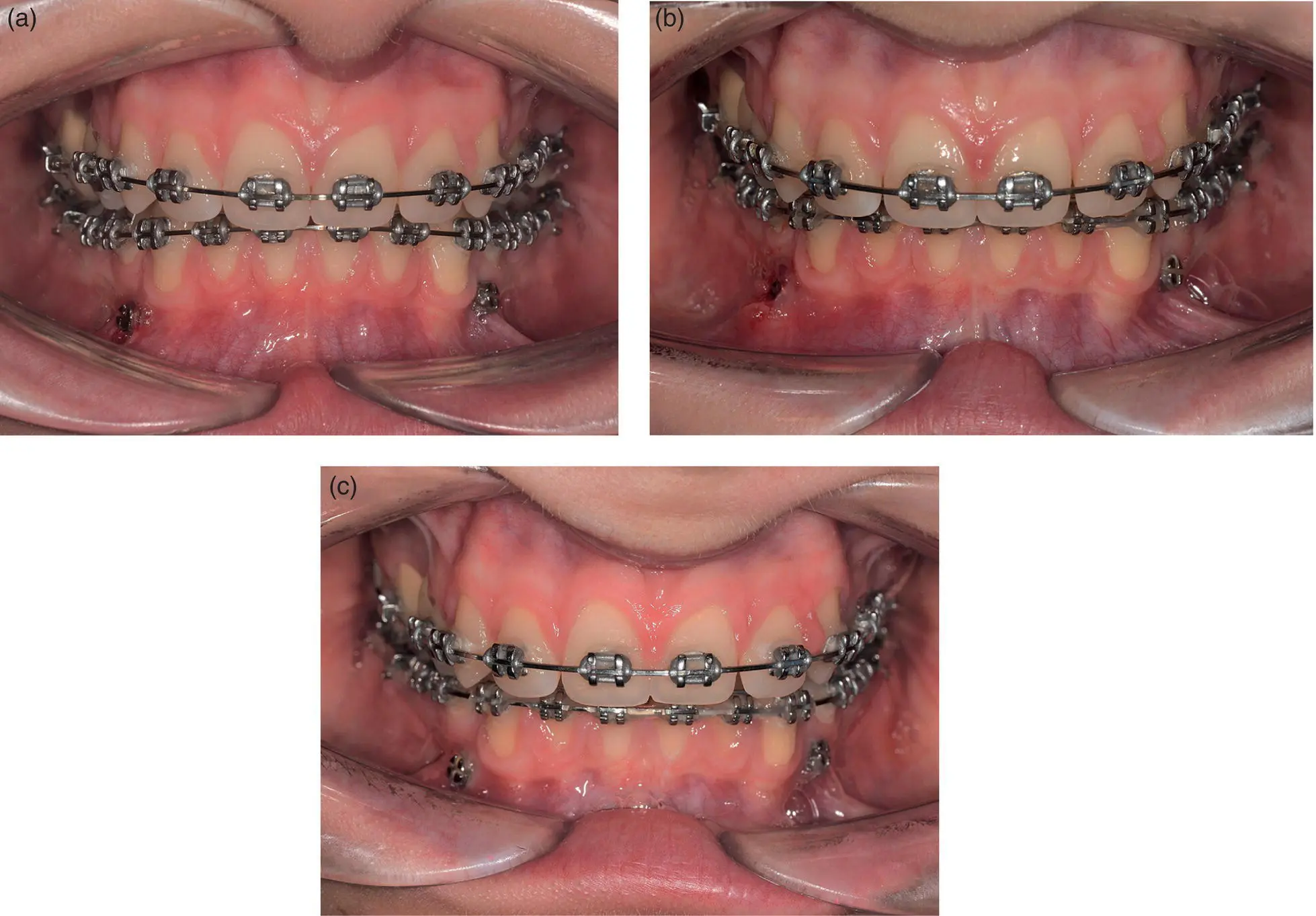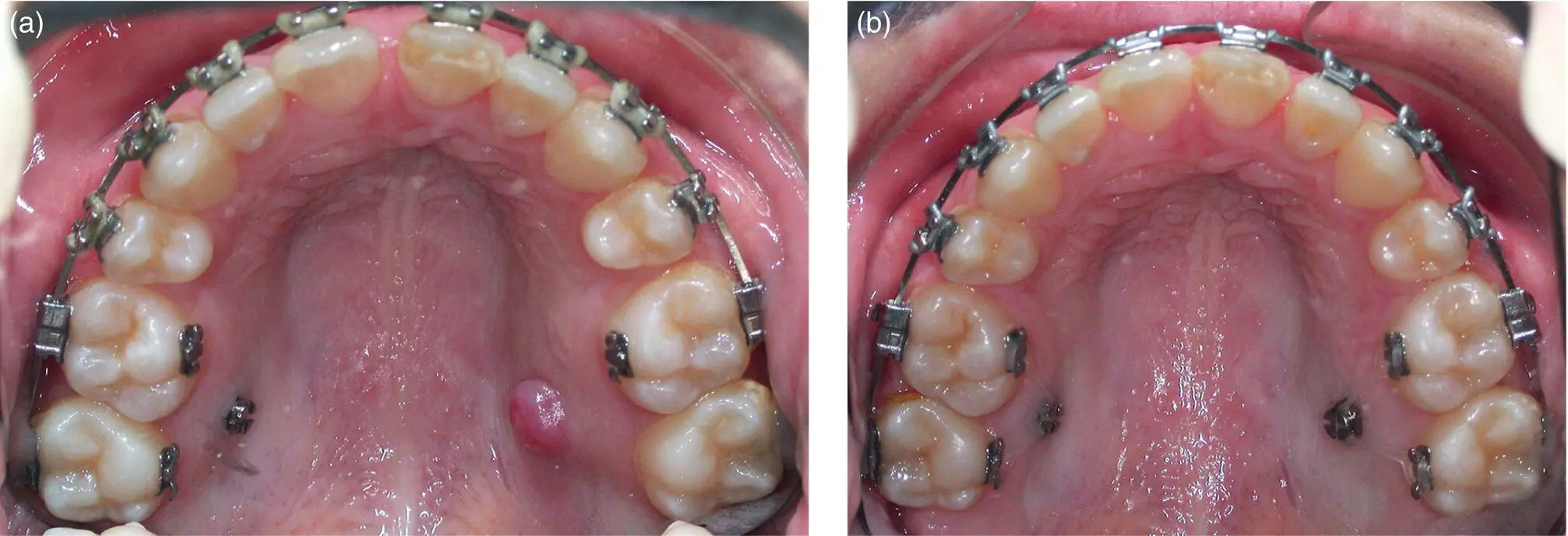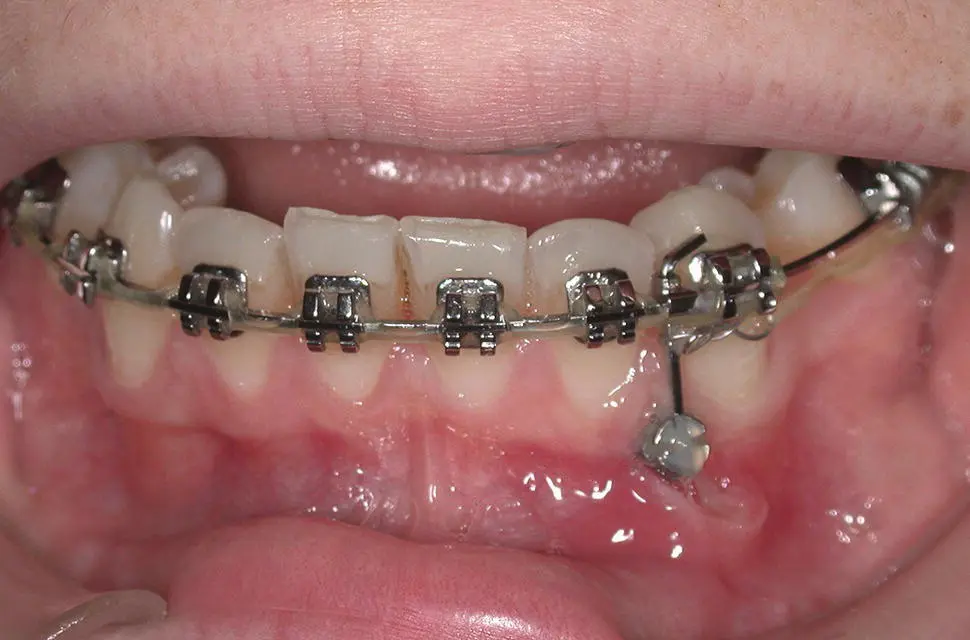
Figure 1.5 Overgrowth of the labial sulcular tissues caused by these mandibular mini‐implant insertions within loose mucosa in this orthognathic surgical case (a). Local anaesthetic infiltration injections were required for the hyperplastic tissue to be peeled off the implant heads for their removal (b).
The majority of patients appear to experience mild pressure‐related pain at the time of insertion.
1.15 Soft Tissue Problems
The most common soft tissue issue related to mini‐implant usage is chronic low‐grade peri‐implant inflammation. This is analogous to gingivitis around the mini‐implant neck, and is usually superficial and self‐limiting. It is more likely if the mini‐implant is either inserted into an area of mobile mucosa ( Figure 1.6) or overinserted (partially submerged) in attached gingiva ( Figure 1.7). If tissue hyperplasia fails to resolve with oral hygiene measures, and either interferes with use of the mini‐implant or causes patient discomfort, then the mini‐implant should be removed. Fortunately, acute infections are rarely seen. For example, an audit of my first 500 mini‐implant insertions confirmed that only one patient had returned to clinic within several days with a painful, inflamed soft tissue swelling around a mini‐implant. This episode of acute infection was readily resolved by immediate explantation of the mini‐implant, without the need for antibiotics.
It is also unlikely that peri‐implant colonisation by specific pathogenic bacteria is responsible for infection problems in failed mini‐implants, as demonstrated by microbiological studies (comparing successful and failed mini‐implant flora) [62–65]. Instead, soft tissue causes of failure are probably related to generalised inflammation effects. Even then, it is likely that the soft tissue influences on stability are small compared with other factors such as root proximity.
The labial or buccal mucosa adjacent to a mini‐implant head may occasionally be traumatised, manifesting as a mucosal ulcer ( Figure 1.8). This is most likely to occur if the mini‐implant has a prominent profile (a long head and neck distance from the tissue surface) or sharp edges, or it is inserted in or near loose mucosa. Conversely, mucosal hyperplasia or ulceration may occur if the traction auxiliary (in direct anchorage scenarios) impinges excessively on the underlying mucosa, especially in the presence of poor oral hygiene ( Figure 1.9).
1.16 Mini‐implant Migration
This depends on the head (and neck) to body ratio, on the degree of bone support (stability), and on the relative force level. In effect, both self‐tapping and self‐drilling mini‐implants may tip and/or translate bodily in the direction of the applied force [66–70]. This is problematic if it causes the mini‐implant head to approximate an adjacent bracket or crown and cause soft tissue impingement or difficulty in utilising the mini‐implant head.

Figure 1.6 (a) Photograph of lower anterior mini‐implants immediately after insertion. (b) Hyperplasia of the loose sulcular mucosa around the right mini‐implant one month after insertion. (c) Effective oral hygiene measures have resolved the hyperplastic tissue problem on the right side eight weeks later, enabling the continued use of this mini‐implant.

Figure 1.7 (a) Hyperplasia of the palatal mucosa covering an overinserted mini‐implant in the palatal alveolar site between the left molars. (b) Normal tissue appearance after simple excision of the hyperplastic tissue and replacement of this mini‐implant. Minor peri‐implant hyperplasia is seen on the right side.
1.17 Biomechanical Side‐effects
In many respects, conventional fixed appliances often only exhibit subtle biomechanical side‐effects such as frictional binding, tooth tipping and anchorage loss, because these effects are usually localised to single teeth or a group of several teeth. For example, traction applied at the coronal level (to a bracket) may result in tipping and poorly controlled bodily movement of that tooth. Since the adjunctive use of mini‐implants provides more profound anchorage, active in all three dimensions and extrinsic to the fixed appliance, the side‐effects may also be more strongly expressed and affect the entire arch (when continuous arch mechanics are utilised).

Figure 1.8 Labial ulceration caused by this mandibular mini‐implant's insertion at the mucogingival junction and by the active movement of the adjacent labial sulcus.

Figure 1.9 (a) Elastomeric traction auxiliary in contact with the alveolar mucosa following insertion of maxillary buccal mini‐implants. (b) Maxillary alveolar ulcerative gingivitis after one month with the powerchain in situ , along with generalised gingival hyperplasia resulting from poor oral hygiene. (c) Photograph taken a further four months later with new traction applied following an improvement in oral hygiene.
Two pertinent examples of this occur if oblique traction is applied from a mini‐implant directly to a canine bracket for anterior segment retraction, with either a flexible or a rigid archwire in place. In the first instance, this oblique vector of traction encourages the canine to tip distally causing the flexible archwire to exhibit a ‘rollercoaster’ bowing phenomenon ( Figure 1.10a). In the latter situation, the oblique traction causes a rigid archwire to rotate the entire arch (around its centre of rotation near the premolar apices), causing a combination of incisor extrusion and retroclination and molar intrusion ( Figure 1.10b). This manifests clinically as a molar openbite, with development of a vertical step between the first and second molar teeth (if the second molar is unconnected).

Figure 1.10 Diagrams showing the vertical side‐effects of an oblique vector of traction from a buccal mini‐implant to the anterior teeth on (a) flexible and (b) rigid archwires. Distal tipping of the canine and a rollercoaster bowing of the archwire occur in scenario (a), whilst predominantly molar intrusion occurs in (b).
1.18 Factors Affecting Mini‐implant Success
A large number of mini‐implant research papers have been published in the orthodontic (and to a lesser extent the surgical and dental implant) literature at an ever‐increasing rate since the start of this millennium. This collective evidence provides a sound basis for mini‐implant usage, although it may be difficult for orthodontists and dental colleagues to keep track of all this new information. Consequently, Chapters 2– 4aim to collate and summarise the essential findings of the most relevant scientific and clinical research papers, in order that orthodontists may both understand and maximise their clinical usage of mini‐implants. In general, the factors determining success may be divided into three categories and these will be discussed sequentially in the next three chapters.
Читать дальше


















